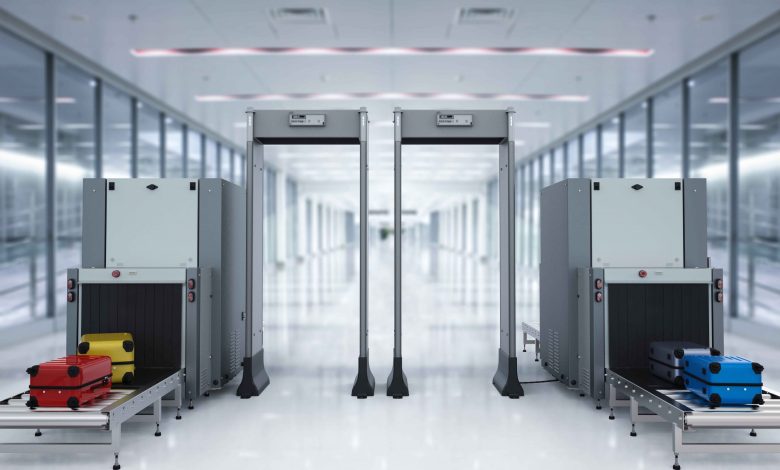How do Archway Walk through Metal Detector Detects

Anyone who has traveled by plane has almost certainly gone through a metal detector. Schools, sporting events, government buildings, and concerts have all deployed these security gadgets. They’re part of a larger security system that includes cameras, door access control, and paging systems in the event of an emergency. Metal detectors are both efficient and secure. They contribute to your safety and security in the same way as IP cameras and door access control do. This is how they function.
Passengers are screened at airport security checkpoints using both walk-through metal detectors and millimeter wave advanced imaging equipment (commonly known as body scanners).
According to Jeff Price, professor of Aviation Management at Metropolitan State University of Denver and lead author of the textbook Practical Aviation Security, walk-through metal detectors use an electro-magnetic coil to create a magnetic field that is disrupted when another piece of metal is introduced, such as a gun or a belt buckle.
Since the early 2000s, most airports have had millimeter wave devices (sometimes known as full-body scanners). According to the airport, the machines’ automated target recognition software doesn’t create passenger-specific images (as the ill-fated, invasive backscatter technology did), but rather uses technology that auto-detects potential threats by indicating where something might be wrong on a generic outline of a person. “They are not x-raying passengers; the radio waves that are employed are on the opposite end of the spectrum,” said Price. They function by “bouncing radio waves off a person to give a virtual X-ray.”
Metal Detectors and Their Science
The metal detector is based on the laws of James Clerk Maxwell (1831–1879), a Scottish physicist. He identified a link between magnetism and electricity. A coil of copper wire wrapped around a metal nail is an example of the relationship. The metal nail becomes magnetic when current is introduced to the coil.
A magnetic field is created when an electric pulse is transmitted through a coil of wire. When the field collides with a metal object, it reflects back and can be detected using a second wire coil. The size and timing of the detected pulse are utilized to determine the object’s size and position.
How They Operate
Pulse induction (PI) technology is commonly used in walk-through metal detectors. Powerful, quick bursts (pulses) of current are sent through the coil of wire by the PI systems. A brief magnetic field is generated by each pulse. A reflected magnetic field is formed when a piece of metal travels through a magnetic field. This magnetic field subsequently reacts with the receiver coil, causing the alarm system to go off. This starting spike lasts a few microseconds and causes a current to flow through the coil. The reflected pulse is the succeeding current that lasts roughly 30 microseconds.
A typical PI-based metal detector sends roughly 100 pulses per second, however this might vary depending on the brand and type, ranging from about 25 to over 1,000 pulses per second.
The enormous magnetic fields created by walk-through metal detectors fill the whole space inside the rectangular arch of the metal detector. If a person walks through the metal detector and the alert goes off, airport security is notified that this individual may be concealing a dangerous metal-based weapon, such as a knife or a gun, and additional investigation is carried out.
Metal detectors with numerous zones can not only sound an alarm but also tell a security officer where the metal object is situated.
Multiple coils in multi-zone walk-through metal detectors generate a separate detecting zone. They are capable of detecting several things and displaying all of the locations where they can be found. Systems with up to 33 zones are available. The alert lights on the unit’s side make it more easier for the security guard to locate the object. Take a peek at our video on “How Walk-through Metal Detectors Work” to learn more.
Metal Detectors for Walk-Throughs are both safe and effective
“Even though magnetic fields [produced by metal detectors] are a sort of radiation, the radiation the machine releases is nonionizing,” the Health Physics Society said in a fact sheet on airport security. [and] does not harm living organisms. As a result, even repeated exposure to metal detectors poses no risk of radiation.” With this in mind, metal detectors in airports, schools, and companies are a very effective and safe way of enforcing security.
Consider metal detectors as part of a larger security strategy
There is no security mechanism that can guarantee 100 percent safety. Assess how this one instrument will fit into a larger security plan as you consider the viability of a metal detector program for your schools, and be sure to manage expectations among students, staff, and the community.
Close engagement with local law enforcement, open communication between students and faculty, and thorough training for all stakeholders are all important components of the most effective school safety programs.
Metal detector programs can help certain schools lower the danger of weapons-related violence, but they can’t work in isolation. When creating a thorough security plan, you must consider a number of factors:
- Entrances that are secure and locked
- Main entrances with bullet-resistant doors and/or glass
- Security cameras are installed at strategic spots across campus.
- Policies for reporting suspicious activity, gaining access using ID cards, and so on.
- Staff and perhaps kids should receive active-shooter incident training.
- Drills to prepare kids and faculty for a lockdown
- To handle security and create relationships, school resource officers are used.
- Plans for informing the community about training activities, events, and other important information
If your school decides to establish a metal detector program, make sure kids, staff, parents, and the community are all aware of the technology’s capabilities and limits. Parents and community members are frequently yearning for a quick fix, but metal detectors, like any other security device, aren’t a panacea.
What you can do to help
Be aware of the dangers. Airport screening keeps passengers safe by detecting hidden weapons and other risks that are not permitted on board. Backscatter x-ray systems and millimeter wave devices pose a very low risk of health impacts. You are not required to walk through these machines if you are concerned about x-ray or millimeter wave screening. Instead, you can request a pat-down search.
Summary
Magnetic fields are used by archway metal detectors to detect metal that goes through them. Maxwell’s equations are at the heart of how they function. Multiple detection zones are included in the most recent detectors, allowing them to pinpoint the exact location of the metal that is producing the alarm. They’ve been shown to be a safe and effective way to keep things secure.





